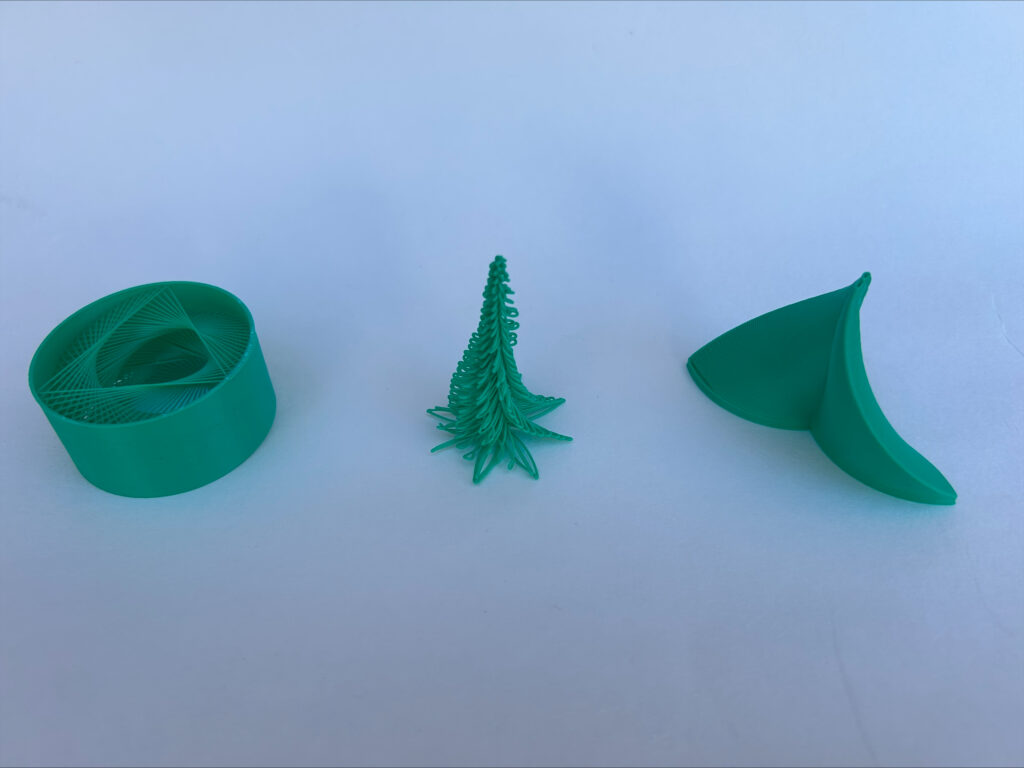
Introduction
This project pushes the boundaries of 3D printing by venturing into a space where traditional slicing software no longer charts the path. Instead, custom generated GCode commands take forth, using a 3D printer to manifest forms that defy the flat layered constraints of conventional prints. Through this exploration, I developed three unique vessels, embodying a distinct approach to understanding the printers capabilities and highlighting the intricate possibilities beyond planar layering.
Concept and Design Approach
Vessel 1: The Spiraling Helix
The first vessel emerged from the concept of rotational symmetry. I envisioned a cylindrical form featuring an internal array of rotating triangles. As each layer builds upon the last, the triangles spiral upward, creating an elegant helical effect. The resulting shape, when viewed from above, presents a secondary pattern, a smaller circular outline born from the negative space of the triangles’ arrangement. The GCode for this form was meticulously crafted using Rhino Grasshopper, requiring a delicate balance between rotational commands and precise extrusion control.
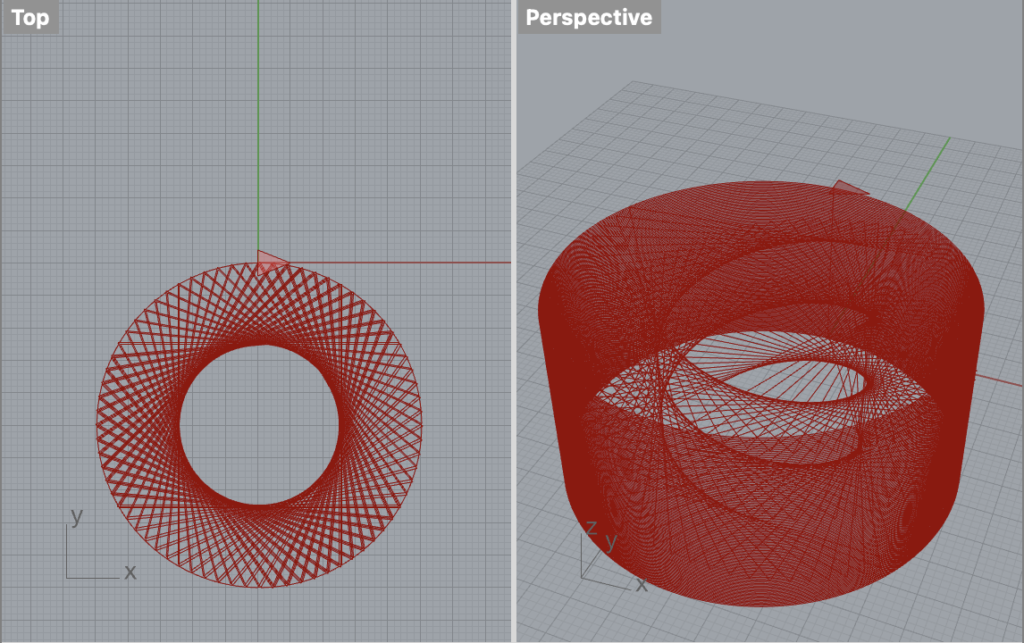
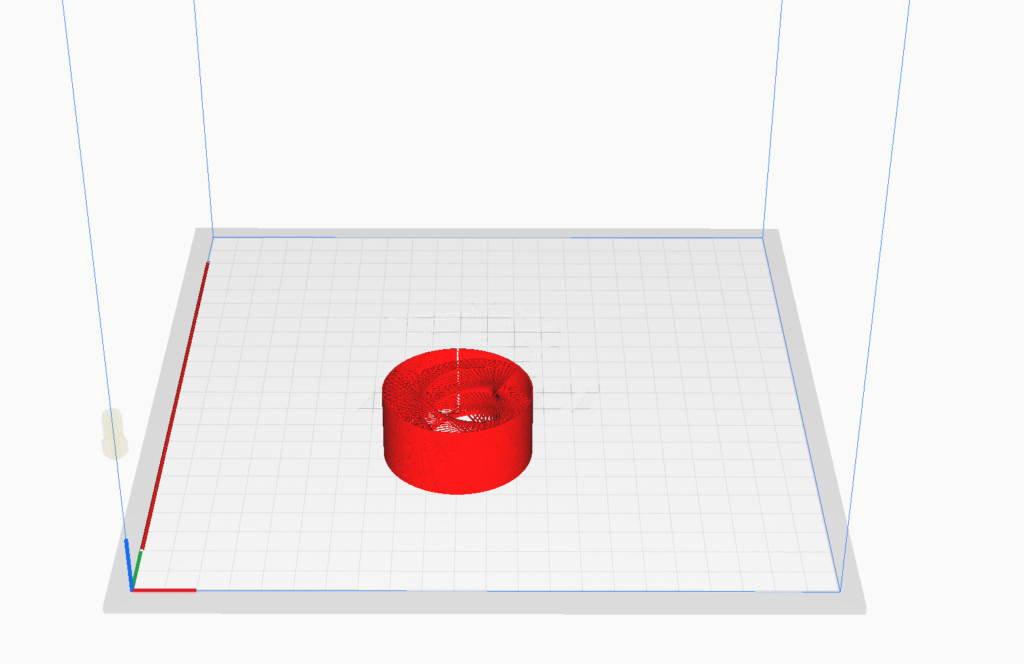
Design Methodology:
- Utilization of mathematical functions to calculate the trajectory and extrusion rate for the spiraling triangles.
- Incremental rotation of the triangles in each layer to achieve the desired spiral effect.
- The challenge of supporting the structure as it builds, given the absence of infill or traditional supports.
Vessel 2: The Ascending Foliage
The second vessel took inspiration from organic growth. In this design, pairs of leaves connect at their tips and layer upon each other, gradually reducing in size and shifting position to create a spiraling ascent. The form narrows and becomes more pointed at the apex. This vessel’s creation required an iterative approach to GCode programming, where each layer not only reduced in scale but also shifted in orientation, demanding the 3D printer to perform a complex ballet of movements.
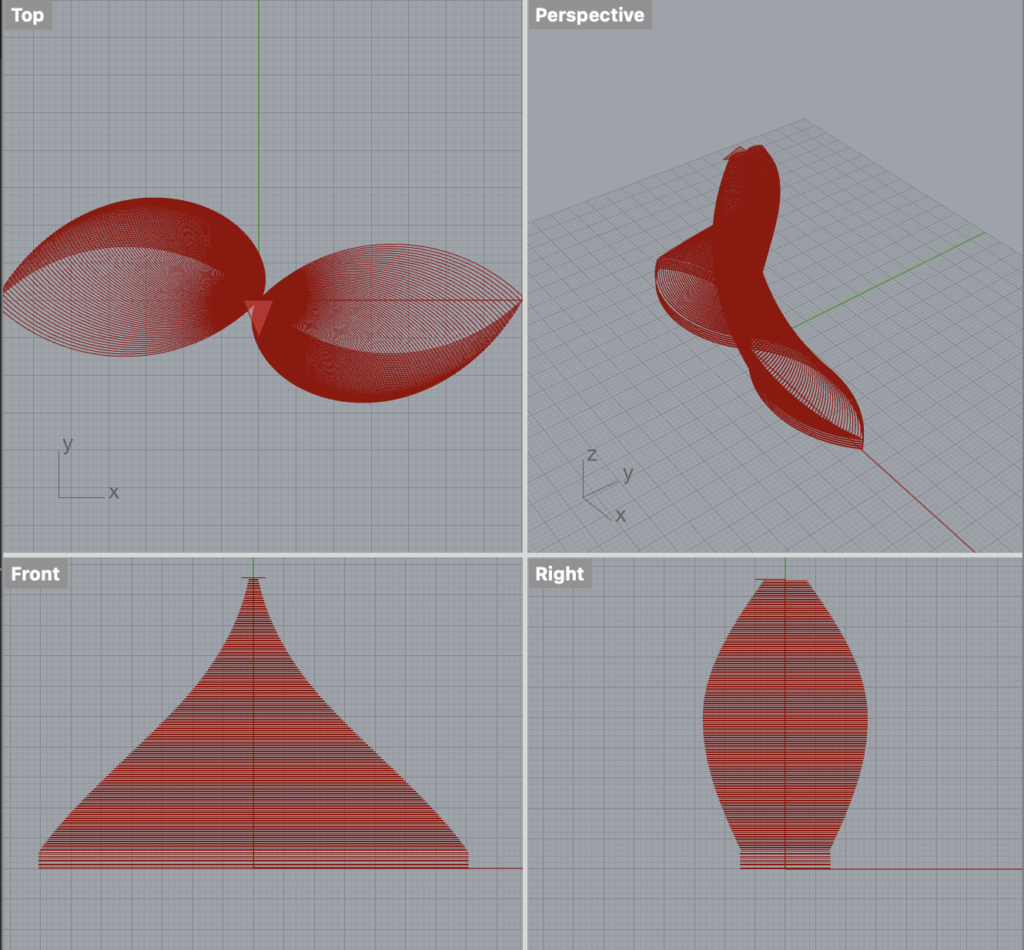

Design Methodology:
- Programming a diminishing scale for each subsequent layer to simulate natural growth.
- Introducing a slight angular shift with each new layer to create the spiral effect.
- Ensuring that the overlapping leaves bonded sufficiently while maintaining the integrity of the overall form.
Vessel 3: The Pine Tree
The final vessel draws its form from the drooping branches of a pine tree, capturing the downward trails of its branches. This creation stands out by printing in mid-air, allowing the extruded filament to droop naturally, creating an organic and somewhat erratic pattern reminiscent of tree leaves. As the structure rises, the leaves begin to rotate, introducing movement in the z-plane and enhancing the tree-like appearance. This vessel demanded an understanding of the material behavior and a novel approach to GCode programming to orchestrate the unsupported starting conditions and subsequent rotations.
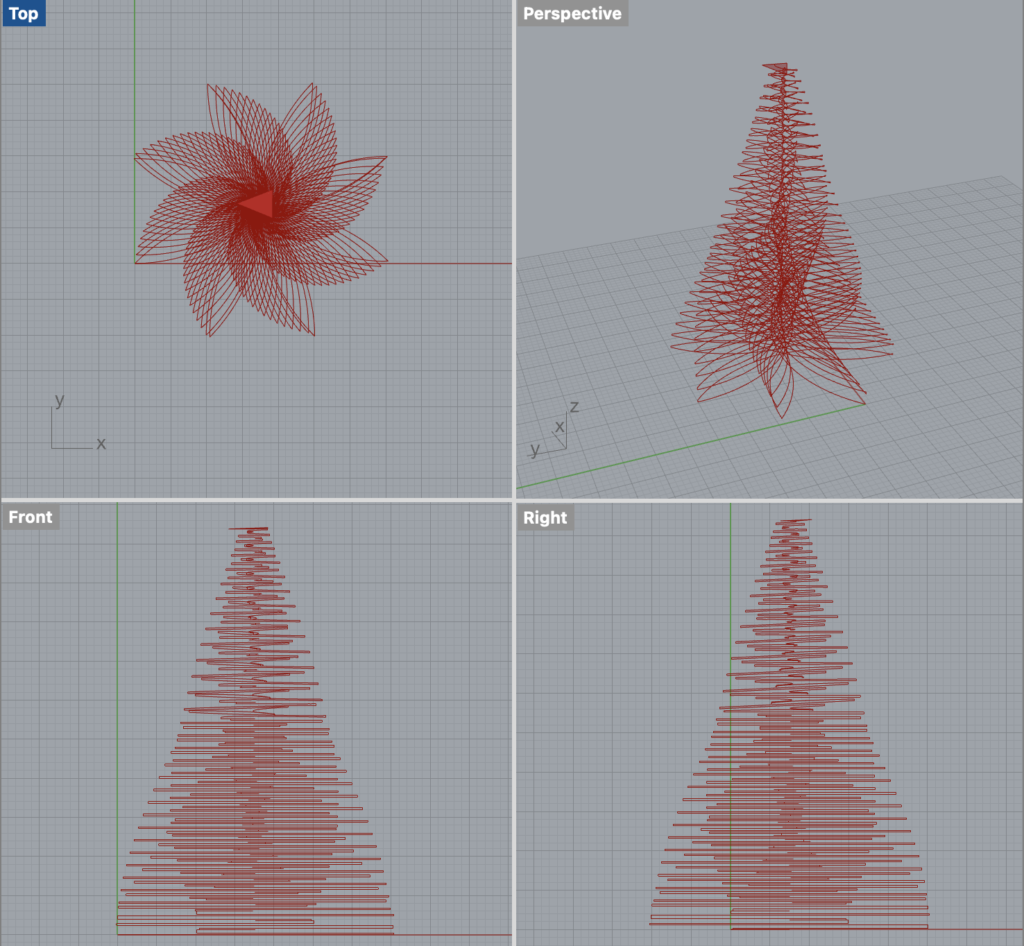

Design Methodology:
- Implementing mid-air printing techniques to allow for natural drooping of the material.
- Gradually introducing rotations to mimic the randomness of nature and introduce printing movement in the Z plane.
- Careful monitoring of the extrusion rate and cooling to ensure structural integrity and to achieve the desired aesthetic effect.
In each vessel, the convergence of code, material, and machine dynamics presents a different dimension of digital fabrication, showcasing what lies beyond the conventional layers of 3D printing and into the sculptural potential of GCode manipulation.
Development Process
The journey of each vessel from concept to object required an iterative and reflective process.
Vessel 1 (The Spiraling Helix)
The development of the first vessel began with geometric explorations. I studied the mathematical underpinnings of spirals and rotational symmetry, experimenting with different angles and numbers of layers, I identified the critical angles and intersection points that would allow the structure to support itself as it ascended.
Vessel 2 (The Ascending Foliage)
The second vessel’s development involved observing natural forms, particularly how plants grow. These observations were translated into digital representations, which were refined into the final design.
Vessel 3 (The Pine Tree)
The third vessel was heavily influenced by material behavior. I conducted a few tests to understand how different extrusion speeds and temperatures affected the filament’s ability to droop and bond in mid-air. This experimentation was crucial in achieving the desired ‘tree-like’ aesthetic and structural integrity of the design.
Technical Implementation
The technical implementation required bespoke GCode instructions for each vessel, going beyond standard slicing software to manually control the printing process.
Vessel 1 (The Spiraling Helix)
Using Rhino Grasshopper, I crafted a custom script that generated GCode to orchestrate the printer’s movements. This script controlled the extruder’s path to create the rotating triangles, managing the precise angles and distances needed for the spiral effect. The gradual decrease in the size of the triangles was achieved by scaling the step size in the script, requiring careful calibration to maintain the structural integrity of the cylinder.
Vessel 2 (The Ascending Foliage)
The G-Code for the second vessel was generated by a script that mimicked growth patterns. By systematically decreasing the scale and introducing a rotational offset with each new layer, I created a spiraling stack of initial leave figures. This required a loop within the script that could incrementally adjust the printing parameters, an approach that emulated natural growth within a controlled, digital environment.
Vessel 3 (The Pine Tree)
The third vessel’s G-Code had to manage the unpredictable nature of printing without direct support. This involved creating a script that could initiate extrusion at a precise point above the build plate, allowing the filament to fall and cool into a drooping form. As the print progressed, the script gradually introduced rotations, creating a randomized, more natural effect. The technical challenge here was to maintain the balance between randomness and control to ensure the print’s success.
In all cases, the technical implementation was a balance of predicting the physical properties of the extruded material and using computational algorithms to create forms without using a conventional 3D printing software. These vessels represent not just the product of their respective scripts but also the embodied knowledge gained through the process of their creation.
Final Results
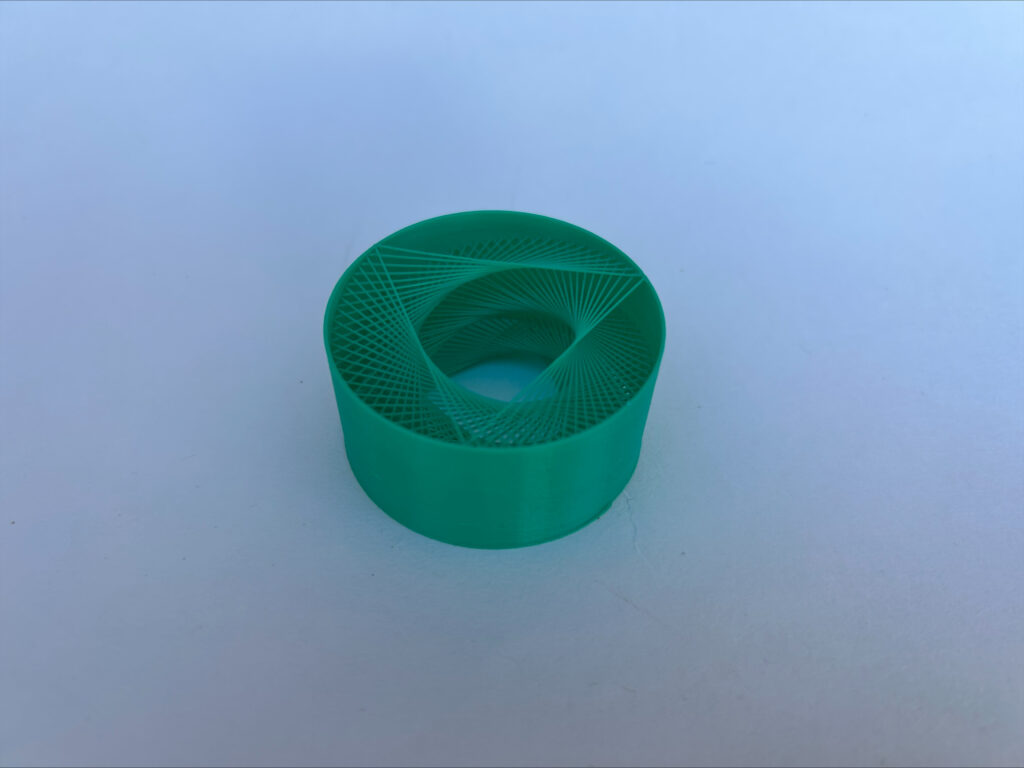


Conclusion
This project has been a great exercise in pushing the boundaries of 3D printing through the direct manipulation of GCode. It revealed a more intricate understanding between code and material that allows for the creation of structures beyond the scope of traditional slicers. With each vessel, a deeper understanding was gained, not only of the technical aspects of computational fabrication but also of the aesthetic potential lying within the code itself. The iterative process, from concept to physical form, highlighted the importance of adaptability and the great outcomes that result from a symbiotic relationship with the machinery.
In summary, the venture into creating these unique vessels has underscored the vast possibilities that open up when we step beyond conventional fabrication methodologies. As the project concludes, it brings with it an anticipation for future explorations where the code becomes an artistic medium, and the printer, a familiar tool to construct imagination into physical objects.
Code
https://handandmachine.org/classes/computational_fabrication/wp-content/uploads/2023/11/triangles.gh
https://handandmachine.org/classes/computational_fabrication/wp-content/uploads/2023/11/tree.gh
https://handandmachine.org/classes/computational_fabrication/wp-content/uploads/2023/11/treeZ.gh